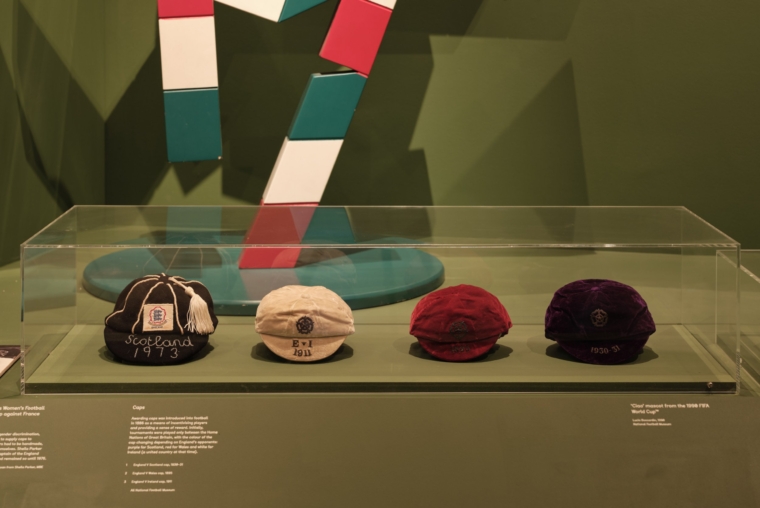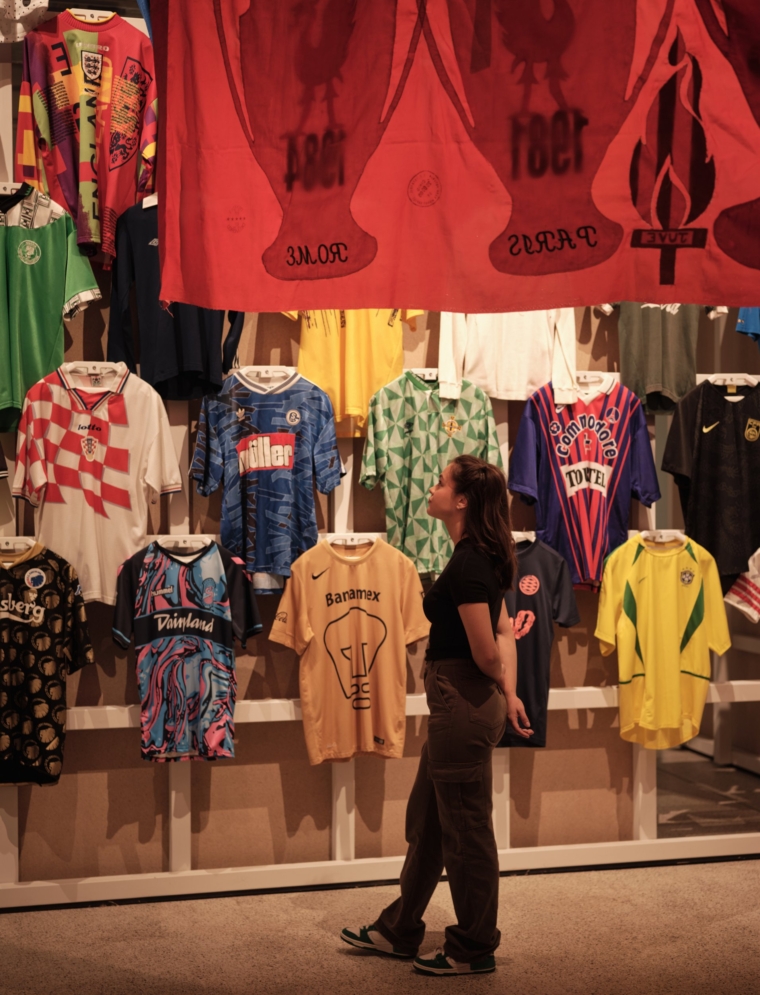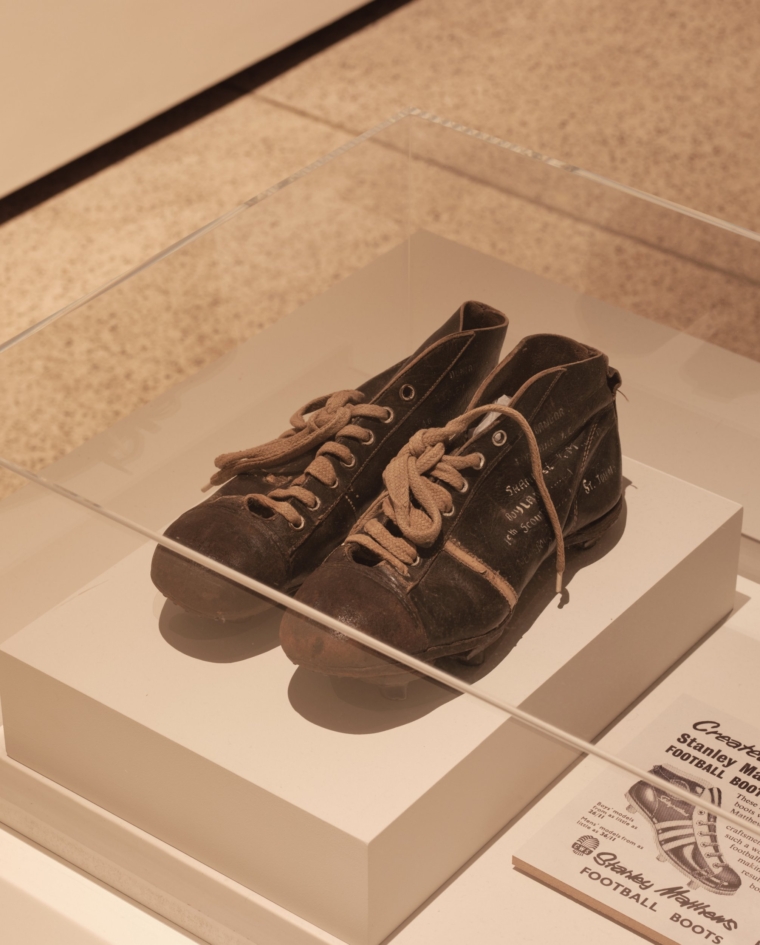Oscar Wilde’s quip “football is all very well as a game for rough girls, but is hardly suitable for delicate boys” came to mind while gazing at the “Girl’s Football Boot from 1890”. This fearsome-looking black boot, featuring a steel toe cap, is one of the “early doors” items to encounter in Football: Designing the Beautiful Game, the first major exhibition to scrutinise football extensively through the lens of design.
The Design Museum’s show, timed for a World Cup year, is divided into five sections: Performance, Identity, Crowds, Spectacle and Play. It begins by showing the evolution of football equipment, including gloves, whistles and shin pads, over the game’s history.
You are drawn in immediately, marvelling at how balls and boots from a bygone age have been transformed into modern lightweight versions. Even so, there is something charming about artefacts, especially the Adidas boot, with its huge studs, used by England’s Geoff Hurst to score the hat-trick that beat Germany to win the 1966 World Cup. The black boots, on loan from the exhibition’s content partner, the National Football Museum in Manchester, were later dipped in bronze and now resemble Robbie Savage’s skin after a fake-tan session.
Another treat is the two footballs used in the inaugural 1930 World Cup Final between Argentina and Uruguay – balls that weren’t too far in design from the primitive Harrow School one from the early 19th century. This object looks more like a giant leather pie than the sort of aerodynamic ball that major sporting goods brands now spend a fortune developing.
The scale and manufacture of balls has changed dramatically – something that’s explained in two captivating videos – although it is hard to imagine how the Barcelona team of Messi, Iniesta and Xavi could have mastered their delicate tiki-taka short-passing game with Victorian balls, which doubled in weight if they absorbed rain. Tiki-taka features in a brilliant wall graphic about the evolution of the formation board. For any football nerd (I hold my hands up), it is fascinating to scrutinise the different tactical approaches coaches have tried over time.

The logo-free shirts on display are a welcome reminder of an age before players looked like tacky one-man advertising hoardings. My favourite was Pelé’s iconic yellow Brazil top, complete with gorgeous badge, from the 1958 World Cup Finals. The shirt looks tiny, but he was just 17 at the time. The oddest kit is Cameroon’s all-in-one green and red Puma outfit from the 2004 African Cup of Nations. This bizarre “onesie” earned them a £160,000 fine from Fifa and was never tried again, sparing players some embarrassing shirt-swapping moments.
The exhibition coincides with the 150th anniversary of the Football Association, an organisation whose historical record towards women’s football is shameful. Although around 80 per cent of exhibits deal with the men’s game, curator Eleanor Watson and assistant Rachel Hajek illuminate the deep roots of women’s football here. At the end of the First World War, there were 150 women’s clubs in the UK, a feat that didn’t stop the FA, in 1921, from declaring that “the game of football is quite unsuitable for females”. It outlawed women from playing professionally.
This absurd ban lasted until 1971 – and, even then, FA dinosaurs continued to disgrace themselves, something deftly demonstrated here by showcasing Sheila Parker’s women’s cap for England from 1973. “In what was an act of gender discrimination, the FA initially refused to supply caps for female players, so theirs had to be handmade, often by the players themselves,” says the display caption.
Watson says “inclusivity was very definitely an aim”, with displays that include the 1999 Nike Air Zoom boot designed for star US player Mia Hamm, and the Nike Pro Hijab, which was “legalised” by Fifa as late as 2014.
The women’s game is also represented in the trophies, vintage posters and programmes scattered throughout an immersive set design. There are fun interactive elements, where kids can get their kicks designing kits (with rearrangeable strips) or making stadiums (with shaped blocks), or savouring the match-day experience on a giant screen from terrace-like seating.

Architects play an important role in the way football is watched and there is an eye-catching wooden model of the Municipal Stadium of Braga in Portugal, known as “The Quarry” because the arena is carved into the side of a mountain. Also on show are Herzog & de Meuron’s ambitious plans for redeveloping Stamford Bridge – a design inspired by Westminster Abbey. The recent exit of Vladimir Putin’s oligarch pal Roman Abramovich, however, may mean these Chelsea stadium plans remain a museum piece.
A stark photograph after the Ibrox Stadium Disaster of April 1902, when 25 fans were killed and 517 injured during a match between Scotland and England – deaths caused by shoddy wooden seating – perfectly encapsulates the negligent attitudes towards fans in the 20th century. This culminated in the 1989 Hillsborough tragedy, and the giant Memorial Banner, created by survivor Peter Carney, is a moving tribute to the 96 Liverpool fans who suffered unlawful deaths that fateful day.
Manchester United manager Matt Busby said that “football is nothing without fans”. Perhaps because Watson is not a natural devotee, she brings a fresh eye to celebrating the visual ingenuity and passion of ordinary supporters and their amateur design work on flags, banners and badges. A highlight is a beautiful handmade Preston North End scarf from 1964. The humour of supporters is shown in the fanzines that sprung up in the late 1980s, while Dave Newbold’s Half & Barf scarves satirise the preposterous half-and-half scarves that include opposing clubs on the same piece of neckwear.
More on Football
Supporters are far from universally pleasant, however, and one offbeat display marks the phenomenon in the 70s and 80s of the “Hooligan Calling Card”, something pioneered by West Ham’s Inner City Firm when they left them on beaten victims. The Leeds United one even imitates a government health warning (“Leeds United Fans Can Seriously Damage Your Health”), and Watson makes a shrewd point about the British tendency to “fetishise” football hooliganism. These same brawling macho men spent their spare time designing “dorky” homemade stationery, she jokes.
Football is still blighted by sexism, racism, sleaze and greed – let alone the exploitation of migrant labour used to build World Cup stadiums in Qatar – and the exhibition highlights darker aspects of the modern game. The graphic about the rise of betting sponsors, for example, draws attention to the consequent surge in gambling addiction. Nostalgia has its own dangers, though, and the inclusion of a Littlewoods Pools coupon from the 70s is a reminder that betting and football have long been bedfellows.

The final section offers a full blast of sentimentality, with a look at table-top games such as Blow Football and Subbuteo, and the subsequent development of electronic and video games such as Fifa 22. If you really want to be jolted out of wistful thinking, you only have to look at the Subbuteo Official Referee Set in the gift shop, which includes a tiny plastic VAR television.
Watson hopes the exhibition encourages young visitors of all genders to imagine the possibilities of football. As a youthful sportswriter, I had lunch with George Best at a time when his self-destructive drinking was out of control.
I thought of this when I looked at the display showing Best’s first boots, given to him by his parents when he was a teenager in Belfast and when a joyful love of football was his main preoccupation. He even wrote the details of the games in which he scored in white paint on the side of his boots. That exhibit alone is a wonderful reminder of why football is still a magical game.
‘Football: Designing the Beautiful Game’ is at the Design Museum, London, until 29 August

